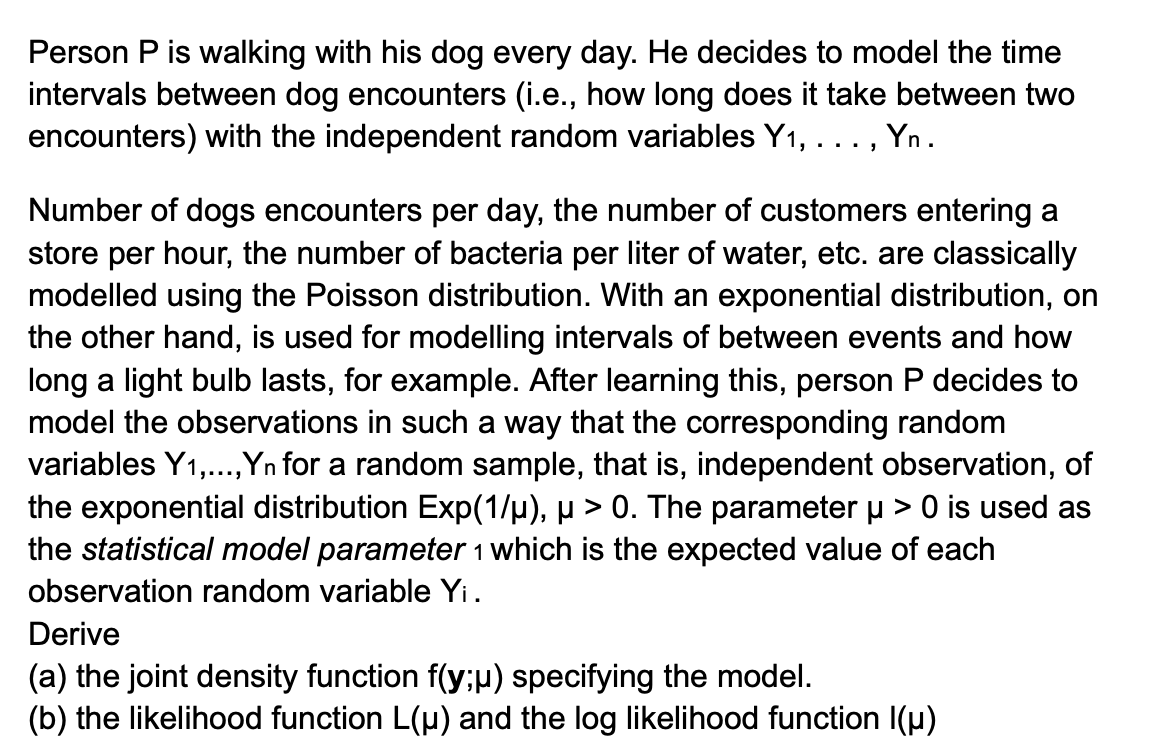Person P is walking with his dog every day. He decides to model the time intervals between dog encounters (i.e., how long does it take between two encounters) with the independent random variables Y1, . . ., Yn. Number of dogs encounters per day, the number of customers entering a store per hour, the number of bacteria per liter of water, etc. are classically modelled using the Poisson distribution. With an exponential distribution, on the other hand, is used for modelling intervals of between events and how long a light bulb lasts, for example. After learning this, person P decides to model the observations in such a way that the corresponding random variables Y1,..., Yn for a random sample, that is, independent observation, of the exponential distribution Exp(1/µ), µ > 0. The parameter μ > 0 is used as the statistical model parameter 1 which is the expected value of each observation random variable Yi. Derive (a) the joint density function f(y;µ) specifying the model. (b) the likelihood function L(μ) and the log likelihood function I(p)
Person P is walking with his dog every day. He decides to model the time intervals between dog encounters (i.e., how long does it take between two encounters) with the independent random variables Y1, . . ., Yn. Number of dogs encounters per day, the number of customers entering a store per hour, the number of bacteria per liter of water, etc. are classically modelled using the Poisson distribution. With an exponential distribution, on the other hand, is used for modelling intervals of between events and how long a light bulb lasts, for example. After learning this, person P decides to model the observations in such a way that the corresponding random variables Y1,..., Yn for a random sample, that is, independent observation, of the exponential distribution Exp(1/µ), µ > 0. The parameter μ > 0 is used as the statistical model parameter 1 which is the expected value of each observation random variable Yi. Derive (a) the joint density function f(y;µ) specifying the model. (b) the likelihood function L(μ) and the log likelihood function I(p)
Holt Mcdougal Larson Pre-algebra: Student Edition 2012
1st Edition
ISBN:9780547587776
Author:HOLT MCDOUGAL
Publisher:HOLT MCDOUGAL
Chapter11: Data Analysis And Probability
Section: Chapter Questions
Problem 8CR
Related questions
Question

Transcribed Image Text:Person P is walking with his dog every day. He decides to model the time
intervals between dog encounters (i.e., how long does it take between two
encounters) with the independent random variables Y1, . . ., Yn.
Number of dogs encounters per day, the number of customers entering a
store per hour, the number of bacteria per liter of water, etc. are classically
modelled using the Poisson distribution. With an exponential distribution, on
the other hand, is used for modelling intervals of between events and how
long a light bulb lasts, for example. After learning this, person P decides to
model the observations in such a way that the corresponding random
variables Y1,..., Yn for a random sample, that is, independent observation, of
the exponential distribution Exp(1/µ), µ > 0. The parameter μ > 0 is used as
the statistical model parameter 1 which is the expected value of each
observation random variable Yi.
Derive
(a) the joint density function f(y;µ) specifying the model.
(b) the likelihood function L(μ) and the log likelihood function I(p)
Expert Solution
This question has been solved!
Explore an expertly crafted, step-by-step solution for a thorough understanding of key concepts.
Step by step
Solved in 1 steps

Recommended textbooks for you

Holt Mcdougal Larson Pre-algebra: Student Edition…
Algebra
ISBN:
9780547587776
Author:
HOLT MCDOUGAL
Publisher:
HOLT MCDOUGAL


Holt Mcdougal Larson Pre-algebra: Student Edition…
Algebra
ISBN:
9780547587776
Author:
HOLT MCDOUGAL
Publisher:
HOLT MCDOUGAL
